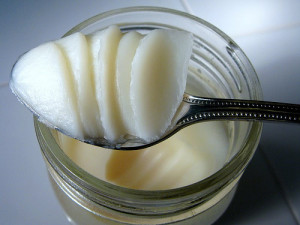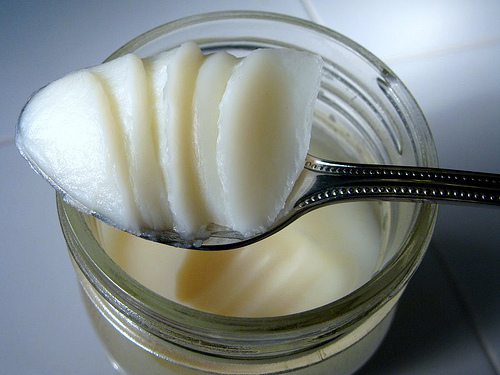Short Answer:
Yes, Lard is Paleo!

Overview of Lard
Lard is a pig fat both in its rendered or unrendered form. Traditional people have been using lard for thousands of years and it has become part of their healthy diet.
Lard is typically 40% saturated fat, 50% monounsaturated fat and 10% polyunsaturated fat. It is solid in room temperature.
Lard is a versatile fat and has been used in cooking since 1900. Because lard is stable in high heat; it can be used for baking, frying, roasting and grilling.
Types of Lard
Lard can be obtained from any part of the pig as long as there is high concentration of fatty tissue. There are three types of lards.
First is leaf lard, which is the best of all the lards, rendered from pigs as it come from the fat deposits surrounding the kidney and inside the loin. It has very little to no pork flavor. Leaf lard is ideal for baking because of its ability to make pies flaky.
Second is the lard obtained from fatback which is a cut of meat from a pig consisting of layers of adipose tissues under the skin of the back and the muscles, without the skin.
Lastly, the lowest grade of all the lards is the one rendered from the soft caul fat. This is the one surrounding the digestive system of pork like the small intestines. Caul fat is normally used as wrapping or casing for sausages, pates and other meat dishes.
Benefits of Lard
Though animal fats have been implicated as cause of heart diseases and obesity due to its saturated fat contents, which is really not the case. Lard is a healthy cooking fat and like other animal fats, lard comes with many benefits:
- Lard is a very good source of saturated fat which is known to protect the heart from heart diseases
- Lard is a healthy source of cholesterol too. Providing good quality of lard to the body can support inflammation management and hormone production
- If lard is made from Pasteur range pork, it is very high in Vitamin D. Vitamin D is a fat soluble vitamin which requires saturated fat to be able to be absorbed by the body and is a powerful immune booster It aids in the absorption of other vitamins and minerals like calcium. It is estimated that 1 tablespoon of lard contains 1000 IU of Vitamin D.
- The main fat in lard known as oleic acid, is a fatty acid that has been associated with decreased risk of depression. It also has anti cancer properties.
- Lard has stearic acid content which has been beneficial in maintaining cholesterol levels
- The myristic and palmitic acids in lard have immune-enhancing and anti-microbial properties
- Lard is very economical. It costs cheaper than other healthy oils. You can even ask it from a butcher and render the fat yourself!
- Lard gives a little pork taste to food that makes it delicious.
- Lard is a stable fat and can be used for high heat cooking. Lard does not easily oxidize with heat which can result to toxic substances. It won’t go rancid and turn into trans fat
Process of Lard Rendering..
There are 2 processes that can be used to render lard. First is the wet process, where the fat is boiled or steamed in water at high temperature and is then separated using a centrifuge. Wet rendered lard is lighter in color and has very high smoking point.
The dry rendering process in contrast is done by exposing the pork fat in high heat pan without the presence of water. Dry rendered fat is somewhat brown in color and is not very stable in high heat.
You can actually render lard yourself. It only requires a few easy steps:
- Purchase free-range pork fat from a local farm.
- Discard any meat from the fat using a knife and cut the pork into small dice. The smaller the part, the more fat is rendered.
- In a pot, heat the pork fat in low to medium heat
- Cover the pot and wait until the fat begins to render oil. Stir occasionally
- The pork fat starts to become brown as it renders. Continue to stir occasionally as the pork fat renders more liquid
- Once the pork fat has completely turned brown, turn off the heat and allow it to cool.
- Use a sieve to drain the fats from the pot to a container and cover it
- Once the lard has cooled, it will become solid. Now it is ready for use.
What Experts Say About Lard.. Is It Paleo?
“When we talk about lard, lard is a complex mixture of fatty acids. All saturated fatty acids affect the body differently. Work from our laboratory, at Bruce Watkins at Purdue, we actually analyzed the quote, unquote lard, or the adipose tissue of wild animals. What we found is that it contains high amounts of stearic acid. Stearic acid is a saturated fat”. – Dr. Loren Cordain
“Lard is relatively stable, with good levels of saturated and monounsaturated fats”. – Mark Sisson
All you ever wanted to know about Lard and Paleo
Paleo Leap. Paleo Healthy Fats
http://paleoleap.com/paleo-fats/
Mark’s Daily Apple. A Primal Primer: Animal Fats
http://www.marksdailyapple.com/yet-another-primal-primer-animal-fats/#axzz3Xpq57Cxp
Chris Kresser. 5 fats you should be cooking with – but may not be
http://chriskresser.com/5-fats-you-should-be-cooking-with-but-may-not-be/
Robb Wolf. How to Render Lard!
http://robbwolf.com/2013/02/21/render-lard-and-free/
Livestrong.com. What Fats Can I Cook With in Paleo?
http://www.livestrong.com/article/553737-what-fats-can-i-cook-with-in-paleo/
The Paleo Mama. I Rendered Lard!
http://thepaleomama.com/2012/03/i-rendered-lard/
Paleolista. The Health Benefits of… Lard?
http://www.paleoista.com/nutritional-approach/the-health-benefits-of-lard-3/
Empowered Sustenance. 10 Reasons to Bring Lard Back
http://empoweredsustenance.com/lard-is-healthy/
Weed ‘em Reap. The TOP 3 Reasons Why You Should Be Eating LARD
http://www.weedemandreap.com/top-reasons-eating-lard/
The Paleo Mom. The Science and Art of Paleofying—Part 3 Leavening and Fats
http://www.thepaleomom.com/2012/11/the-science-and-art-of-paleofying-part-3-leavening-and-fats.html
The Healthy Foodie. HOW TO RENDER YOUR OWN LARD
http://thehealthyfoodie.com/how-to-render-your-own-lard/
Popular Paleo. Making Lard
http://popularpaleo.com/2014/05/06/making-lard/
The Paleo Review. Fat Works Leaf Lard & Pure Tallow
http://www.thepaleoreview.com/2014/02/fat-works-leaf-lard-pure-tallow.html
Other names for Lard
Schweineschmalz
Did we miss anything?
Comment below and let us know what you think. Do you agree with our conclusion?
photo credit: Rendering Lard – Rendered Lard, Cooled & Chilled

